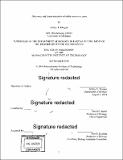Discovery and characterization of stable introns in yeast
Author(s)
Morgan, Jeffrey T. (Jeffrey Thomas)
DownloadFull printable version (11.67Mb)
Other Contributors
Massachusetts Institute of Technology. Department of Biology.
Advisor
David P. Bartel.
Terms of use
Metadata
Show full item recordAbstract
Spliceosomal introns are a defining feature of eukaryotes; they are present in all known eukaryotic genomes, absent from all known non-eukaryotic genomes, and their accurate removal is essential for mRNA maturation. Although smaller ncRNAs can be processed from introns, the introns themselves are considered biologically inert byproducts of splicing; their collective fate post-splicing is to be de-branched and rapidly degraded. This dissertation details the first described instance of a regulated fate and function for excised and de-branched introns in eukaryotes. We observed a set of introns in the budding yeast Saccharomyces cerevisiae's transcriptome that, although rapidly degraded during log-phase growth as expected, accumulate as linear RNAs under saturated-growth conditions and during inhibition of TORC 1, a key integrator of growth signaling. At least 34 introns-1 1% of the introns in S. cerevisiae-show this change in stability. We find no evidence that this stability can be attributed to intron retention in the mature transcript. Instead, introns that become stabilized remain associated with components of the spliceosome post-splicing, likely resulting in their protection from degradation. Compared to other yeast introns, these stable introns have no enriched sequence motifs but do share a short distance between their lariat branch point and the 3' splice site. Indeed, by manipulating this distance, we are able to show a causal relationship between branch-point position and stable-intron formation. To test for cellular functions of stable introns, we created strains with precise intron deletions. We created 20 strains with combinations of up to five introns deleted, with the quintuple mutant eliminating >60% of the stable-intron molecules in the transcriptome. When these strains are challenged with the TORC I inhibitor rapamycin, their growth exceeds that of the parental strain, with a striking relationship (R² = 0.9) between the fraction of SI molecules removed from the transcriptome and the rate of growth under TORC 1 inhibition. Overexpression of native or engineered stable introns suppresses this aberrant rapamycin response. These results indicate that stable introns function within the TOR-mediated growth-signaling pathway of S. cerevisiae, and more broadly, excised introns can be stabilized and coopted to perform biological functions in eukaryotic cells.
Description
Thesis: Ph. D., Massachusetts Institute of Technology, Department of Biology, 2018. Cataloged from PDF version of thesis. Vita. Includes bibliographical references.
Date issued
2018Department
Massachusetts Institute of Technology. Department of BiologyPublisher
Massachusetts Institute of Technology
Keywords
Biology.